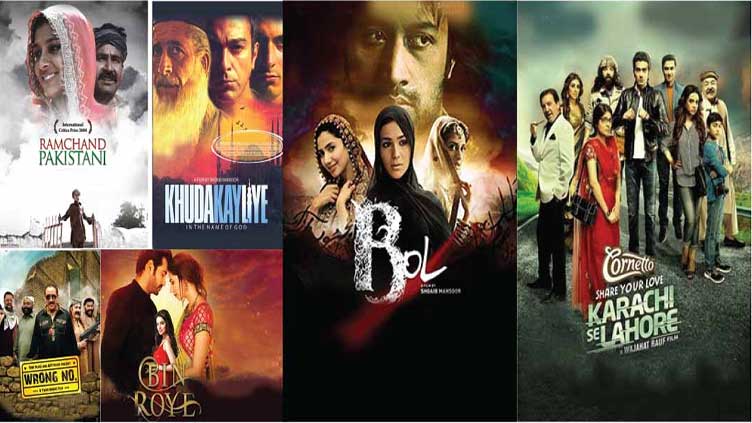In the heart of Pakistan’s creative universe, where stories are spun and dreams flicker on the silver screen, there lies a conundrum that demands our attention. Picture this: the echoes of Maula Jatt’s success still reverberate, but are we content with an occasional thunderous applause? The curtain has risen, revealing a stage where creativity seems to have donned a cloak of predictability. It’s a paradox — a realm filled with talent, yet a narrative that seems stuck in a repetitive loop.
There was a time when Pakistani dramas were a carnival of genres — a feast for every palate. Detective tales such as Andhera Ujala (1984) kept us on the edge of our seats, semi-horror narratives such as Kohar (1991) sent shivers down our spines, and dedicated series for the youngest members of our audience sparked imaginations such as Ainak Wala Jin (1993-1996). Fast forward to today and we find ourselves navigating a landscape dominated by a singular, almost monotonous storyline.
But fear not, for this feature is not a lament. It’s a journey through time and creativity, exploring the rise, fall, and tantalizing potential of Pakistan’s creative industry. As we sail through this tangled mosaic, we’ll unravel the historical threads of diverse storytelling in the Pakistani entertainment industry, dissect the current state of affairs, and cast a discerning eye on the cinematic spectacle, with Maula Jatt standing tall amidst occasional sparks of innovation.
So buckle up for a rollercoaster ride through the realms of Pakistani creativity — where the past meets the present, and the future awaits its call to break free from the chains of creative conformity.
The “Golden” Old
Once upon a time, Pakistani dramas were a symphony of storytelling diversity, a carnival of creativity that left audiences spellbound. It was an era when every drama was a new adventure, and the industry was a kaleidoscope of narratives. In the heyday of Pakistani dramas, genres were not mere labels but portals into worlds unexplored. Shows and movies like “Unkahi“, “Alpha Bravo Charlie”, “Dhoop Kinare”, “AanganTerha”, “Parchaiyan” “Tanhaiyan“, “Heer Ranjha”, “MeraNaam Hai Mohabbat”, “Umrao Jaan Ada” and “Zarqa”exemplified the diversity that once defined our screens. Fast forward to the present, and a noticeable shift has occurred. The vast array of genres has seemingly dwindled to a singular, formulaic storyline.
Dramas and movies, once celebrated for their unpredictability, now appear to follow a predictable script.
The golden age of Pakistani dramas had an undeniable impact on audience engagement. Viewers were hooked not just to a particular show, but to the myriad of possibilities the industry presented. The evolution of dramas and films over the years, however, signals a departure from this once-dynamic landscape.The shift from multifaceted storytelling to a more streamlined approach in today’s dramas is not arbitrary. Commercial considerations and a quest for mass appeal have played pivotal roles. The industry’s pivot towards a specific narrative formula reflects an attempt to meet market demands and sustain financial success.

The “Silver” Present
In the present, the Pakistani drama landscape is a canvas dominated by a limited palette. Themes, once as varied as the colors in an artist’s palette, have converged into a singular hue. The prevailing trend is one of melodramatic family sagas, often revolving around societal issues. While these narratives undoubtedly hold societal relevance, the question that looms is whether the industry’s creative potential is fully realized or somewhat restrained.
Take a glimpse at the current lineup, and patterns emerge. Themes of familial discord, love triangles, and societal struggles are recurring motifs. Popular shows like “Bin Roye“, “MerayPaas Tum Ho”, “Jalan“, “Do Bol” and “Tere Bin” epitomize this trend. The widespread success of these shows is a testament to their resonance with the audience, yet it prompts reflection on the industry’s inclination towards a somewhat repetitive narrative structure.
The pulse of any creative industry is the heartbeat of its audience. Social media platforms serve as arenas where viewers express their thoughts and opinions. A glance at Twitter trends during prime-time drama slots reveals a mix of fervent fandom and critical discourse. While some applaud the emotional intensity of contemporary dramas, others lament the perceived lack of innovation. Contrasting the present with the past invites contemplation.
The decline in the breadth of genres is palpable, and the question arises — is this a result of evolving viewer preferences, market pressures, or a combination of both?
Why This Shift in Pakistani Dramas?
The metamorphosis of Pakistani dramas from diverse narratives to a more streamlined approach is a complex tale influenced by various factors. The industry faces a delicate balancing act — meeting commercial imperatives while nurturing the creative spirit that once defined Pakistani dramas.
• Commercial Considerations: At the core of this shift lies the delicate dance between artistic expression and commercial success. The balance, or perhaps imbalance, is evident in the industry’s quest for box office triumphs and high television ratings. The success of dramas like “Yeh Raha Dil”, “Ishqiya”,“Dil-e-Muztar” and “Kahin Deep Jalay” underscores the financial viability of a specific storyline.
• Impact of Streaming Platforms: The rise of over-the-top (OTP) streaming platforms has further reshaped the narrative landscape. With an ever-expanding global audience, the industry is compelled to produce content that resonates not just locally but also internationally. The influence of global trends, coupled with the pressure to generate revenue, contributes to a narrative homogeneity.
• Audience Preferences: Understanding the modern viewer is akin to deciphering a complex code. The industry’s pivot towards family-centric dramas may be a response to the perceived preferences of a broader audience. Market-driven content creation often hinges on delivering what sells, blurring the line between artistic expression and audience demand.
Parallel Commentary: Pakistani Cinema
Traversing the diverse cinematic landscape of Pakistan, notable films stand out as beacons of success, contributing to the country’s filmmaking legacy.
While successes like “Maula Jatt” have left an indelible mark, the infrequency of such breakthroughs prompts reflection on the industry’s approach to creative diversity.
The triumphs in Pakistani cinema extend beyond singular instances. Films like “Cake” and “Laal Kabootar“ showcase a departure from mainstream narratives, offering audiences refreshing and diverse storytelling experiences. “Cake” delves into intricate family dynamics, and “Laal Kabootar“ explores the gritty underbelly of Karachi, demonstrating the versatility ofPakistani storytelling.
Despite the commercial dominance of romantic dramas and comedies, the emergence of films like “Bol“ and “Khuda Kay Liye“ underscores a potential appetite for thought-provoking narratives. “Bol“ tackles societal issues and family dynamics, while “Khuda Kay Liye“ addresses complex themes of religion and identity.
Exploring genres prevalent in Pakistani cinema reveals a multifaceted landscape. While the industry has seen success in certain formulas, the potential for varied tales is evident. Films like “Manto“ delve into the life of the renowned writer SaadatHasan Manto, providing a glimpse into the intellectual and cultural history of Pakistan.
These instances of innovation showcase the dynamic potential within Pakistani cinema. While challenges persist, these films demonstrate that audiences are receptive to narratives that transcend conventional boundaries. The question remains: can the industry consistently embrace and celebrate this creative diversity to shape a more vibrant cinematic future?

The Role of Talent in the Creative Industry
Within the labyrinth of the creative industry, Pakistan boasts a trove of talent — VFX artists, producers, directors, and animators, each a brushstroke on the canvas of storytelling. Pakistan’s creative industry has indeed witnessed remarkable success stories led by talented individuals in various fields. Here are examples that highlight the role of VFX artists, animators, and visual storytelling in the industry:
• 3 Bahadur” Series (2015, 2016, 2018): Directed by Sharmeen Obaid-Chinoy, the “3 Bahadur” animated film series was a significant success. It showcased the potential of Pakistani animators and storytellers, telling the tale of three young superheroes and their adventures.
• “Maula Jatt” (2019): While the original “Maula Jatt” (1979) was a classic, the 2019 version, titled “The Legend of Maula Jatt,” aimed to redefine Pakistani cinema with its use of cutting-edge VFX. The film, directed by Bilal Lashari, featured stunning visuals and special effects, contributing to its success.
• “Gluco Allahyar and the Legend of Markhor” (2018): This animated film, directed by Uzair Zaheer Khan, gained attention for its visually appealing animation and storytelling. It targeted younger audiences and showcased the potential of the Pakistani animation industry.
In Pakistan’s creative sphere, talents like VFX artists, animators, and directors have played pivotal roles in crafting compelling narratives, showcasing innovation, and contributing to industry growth. Despite these successes, challenges persist. VFX artists creating mesmerizing visuals, producers navigating complex financing, and animators breathing life into stories deserve recognition. Their collective efforts are the bedrock of the industry’s accomplishments. Yet, navigating this field is challenging, involving financial constraints, market pressures, and the pursuit of audience appeal.
Individual triumphs—a VFX artist innovating, a producer overcoming odds, or an animator adding depth to a story—underscore the resilience and potential within the industry’s talent pool.
Case Studies: Successful Creative Endeavors
Within the realm of Pakistani storytelling, which often adheres to conventional narratives, certain films have emerged as triumphs that defy the norm and redefine the boundaries of storytelling. “Zindagi Tamasha,” directed by Sarmad Khoosat, stands out for its courageous exploration of societal taboos. The film’s nuanced portrayal of characters and its examination of religious and societal norms sparked widespread debate, emphasizing the potency of storytelling to challenge established societal paradigms. Despite facing controversies, “ZindagiTamasha“ showcased the industry’s capacity for brave narratives and the need for an environment that encourages creative expression despite societal pressures.

In the family drama genre, “Cake” directed by Asim Abbasioffered a refreshing exploration of familial dynamics, moving beyond the clichés of romantic dramas. The film’s success highlighted the audience’s appetite for narratives digging into the fabric of human connections, departing from formulaic tales that often dominate screens.
“Baji,” directed by Saqib Malik, exemplifies cinematic brilliance through its harmonious collaboration of diverse talents. Blending drama, mystery, and social commentary, the film’s success lies not only in its riveting storyline but also in the seamless integration of VFX artists, cinematographers, and performers. “Baji“ serves as a testament to the potential of cross-disciplinary collaboration, proving that when talents unite, the result is a cinematic masterpiece that captivates audiences and challenges storytelling norms.
The Pakistani drama industry has also proven its mettle in addressing sensitive societal issues through a series of compelling projects. Dramas such as “Udaari“ explored the profound topic of child sexual abuse, sparking conversations and contributing to societal change. “Khuda Mera Bhi Hai”courageously addressed transgender rights and societal acceptance, receiving critical acclaim for its bold narrative. “Cheekh“ explored the complexities of seeking justice for rape, shedding light on societal norms and legal loopholes. “Pyar KeSadqay“ sensitively portrayed mental health challenges, contributing to a more open dialogue on the subject. Additionally, “Dil Na Umeed To Nahi“ tackled human trafficking and child exploitation, while “Ranjha Ranjha Kardi“explored mental health and personal growth.
“Kabuli Pulao” addressed cross-cultural relationships and acceptance. These projects have not only been appreciated by audiences but have also positioned the drama industry as a vibrant and diverse platform. Their success signifies a bright future for Pakistani dramas, showcasing the industry’s potential to tackle pertinent issues and create engaging, thought-provoking narratives that resonate with viewers. The ability to produce such impactful projects sets the stage for a promising and dynamic future, demonstrating that the Pakistani drama industry can remain relevant, vibrant, and socially significant.
What Can Be Done?
The trail ahead is both challenging and ripe with potential in the labyrinth of Pakistan’s creative future. To navigate this terrain successfully, concrete actions and practical solutions are imperative.
• Diversifying storytelling should not be a mere artistic pursuit but a strategic imperative for the industry’s survival and growth. An example of diversifying storytelling in the Pakistani media industry is the film “Laal Kabootar“. Directed by Kamal Khan, this crime thriller marked a departure from traditional romantic or family-centric plots commonly seen in Pakistani cinema. Producers and directors must consciously incorporate a variety of genres into their portfolios, breaking away from the constraints of formulaic narratives. This diversification should be seen not as a risk but as an investment in the industry’s resilience and long-term success.
• Collaboration is not a buzzword; it’s a catalyst for change. The industry can foster collaborative ecosystems where filmmakers, TV producers, and content creators unite to exchange ideas and resources. A notable example of collaboration in the Pakistani media industry is the partnership between the renowned television director Mehreen Jabbar and the acclaimed novelist Farhat Ishtiaq. Their collaboration brought about the successful drama series “Udaari“. “Udaari“ addressed sensitive social issues, including child abuse, and featured a powerful narrative and impactful performances. Establishing platforms for cross-disciplinary collaboration can lead to the birth of narratives that transcend traditional boundaries, captivating audiences across mediums.
• Experimentation should not be a luxury reserved for the few but a cornerstone of the industry’s ethos. Establishing financial support mechanisms, grants, and funds specifically designated for experimental projects can incentivize producers and directors to take calculated risks. This not only injects creativity into storytelling but also cultivates a culture of innovation.
• Artistic visionaries are the torchbearers of change. Implementing mentorship programs that pair emerging talent with seasoned professionals can provide guidance and support for those willing to defy conventions. Platforms such as “Green Entertainment” recognizing and celebrating unconventional storytelling can further incentivize artists to push boundaries.

As we draw the curtains on this exploration of Pakistan’s creative narrative, the call to action reverberates with tangible steps and pragmatic solutions. The journey ahead demands not just words but collective, concerted efforts to reshape the industry’s trajectory.
The era of diverse storytelling beckons as an imperative, not an artistic luxury.
Collaborative ecosystems are not a utopian dream but a practical means to break down silos and foster innovation. Financial support for experimental ventures is not philanthropy but an investment in the industry’s resilience. Championing artistic visionaries is not a gesture but a smart play to unearth and celebrate the untapped potential within.
The future is not a distant horizon; it’s an unfolding narrative shaped by the decisions and actions of today. Pakistan’s creative industry stands at a crossroads, and the time is now to take bold steps, reimagine storytelling, and chart a course toward a future where creativity knows no bounds.
Some Personal Reflections
Standing at the crossroads of admiration and concern, I reflect on the vibrant past of the Pakistani entertainment industry, a source of inspiration and a measure of the present. The prevalence of formulaic narratives, though commercially successful, raises a crucial question: Have we stifled the creative spirit that once defined our storytelling in the pursuit of market validation? As the industry charts its present course, there’s a yearning to return to the bold experimentation of the golden age of Pakistani dramas.
In contemplating the future, optimism prevails amidst reflections on the present. Envisioning a future where creativity flows boundlessly and narratives know no constraints, this feature catalyzes change. It’s a call to industry professionals, storytellers, and audiences to diversify, collaborate, and innovate. This feature aspires to spark conversations that permeate production houses, animators’ studios, and filmmakers’ sets.
Change, in the realm of storytelling, is not an upheaval but an evolution.
My earnest hope is that this feature catalyzes dialogue, inspiring collective introspection within the industry. Envisioning a future where the creative spirit reigns supreme, let stories be woven into the fabric of our cultural identity. In the grand mosaic of Pakistan’s creative journey, may this feature contribute its thread to a canvas painting of a future of boundless creativity—a celebration of the diverse, dynamic, and daring spirit of Pakistani storytelling.




